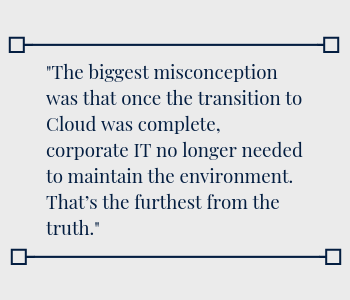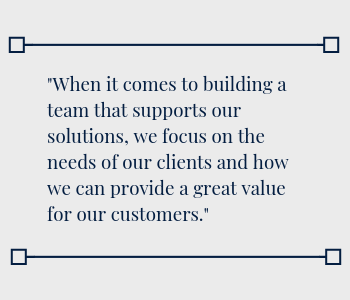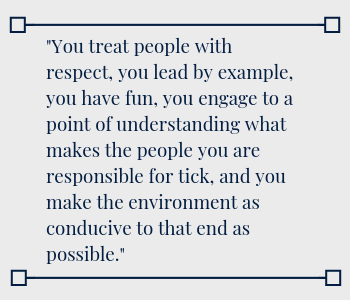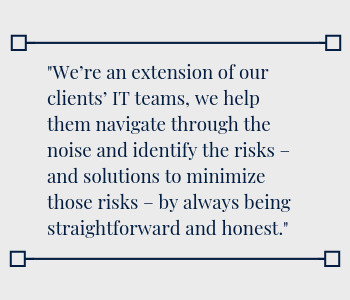November 6, 2018 by Siobhan Climer
Jason Wankovsky, Mindsight’s CTO and VP of Consulting Services, sat down with Siobhan Climer, Mindsight’s Science and Technology Writer, to discuss leadership and technology. As he put it, “My job is to make sure we’re helping our clients grow with the right services and solutions, and that our clients are happy with the results.”
Jason started out delivering pizzas and managing restaurants, and today he heads a tight-knit team of experts at Mindsight who specialize in the technology solutions and services we offer our customers. Despite a wealth of experience in delivering technology, Jason sees his primary role as mentoring and providing opportunities for growth to those with whom he works, who in turn pass along those benefits to clients.
CTO and VP of Consulting Services: Understanding The Role
SC: You have a long title: Chief Technology Officer and VP of Consulting Services. How different are the two roles represented in your title? How do you describe your role to others?
JW: In a company of our size, no matter your title, you wear many hats. The title doesn’t dictate if I do this or I do that. I think the things I do dictate the titles. From a perspective of what my responsibility is to the business, I ensure we are focusing and presenting to the market the solutions our clients and prospective clients need to improve their businesses. People buy solutions to reduce risk, reduce cost, or increase revenue. So, I make sure the solutions we’re providing – whether it’s a technology or a service – achieve those goals for our clients and prospective clients.
 I make sure that what we do, we do the best we possibly can. That means constantly staying on top of what’s going on in the market today and being forward thinking about what’s coming in the next 12-18 months. It means understanding the great solutions available to our clients, what solutions are getting a lot of traction – even though they might not be so great, and what solutions are really great but aren’t getting traction. The latter are the solutions that I might suggest we focus on because those will give our clients an edge in their environments. At the end of the day, we do what helps our clients continue on their paths to success.
I make sure that what we do, we do the best we possibly can. That means constantly staying on top of what’s going on in the market today and being forward thinking about what’s coming in the next 12-18 months. It means understanding the great solutions available to our clients, what solutions are getting a lot of traction – even though they might not be so great, and what solutions are really great but aren’t getting traction. The latter are the solutions that I might suggest we focus on because those will give our clients an edge in their environments. At the end of the day, we do what helps our clients continue on their paths to success.
My job is to make sure we’re helping our clients grow with the right services and solutions, and that our clients are happy with the results.
SC: Can you describe the path you took to your current role, and what skills you gathered along the way that make you successful?
JW: In IT, I think it’s actually been pretty traditional. In life, it’s been a little jagged. I don’t have a degree. And without a degree, a lot of doors are closed to you. When I was 16, I started delivering pizzas and ended up running restaurants for the first 10 years of my professional life. That taught me a lot about business, and I grew more responsible as time went on. At the beginning of the dot com era, the late 90s, I decided to get into IT because there was a lot of growth and opportunity. Taught myself, got a Microsoft certification, put together a resume – I mean, I’d been managing teams of up to 175 for more than 10 years. I had potential.
A guy took me in as his IT Manager. I had 2 or 3 engineers, 100-user company. Well that quickly got bought by a bigger company. Then, all of a sudden, we were 700-users. 6 months later, 2600-users. Then, bankruptcy. And bankruptcy was one of the harsh lessons I learned. The company went from 2600 people to about 45 in six months. A harsh experience, but it was also very interesting.
 I teamed up with one of the former VPs and started a consulting business. Over the next 15 years, I helped build a business from a zero dollar enterprise to a $12 million dollar enterprise, and doubled revenue again and again at other stops along the way. And that’s part of why I’m at Mindsight; to help grow our team and business.
I teamed up with one of the former VPs and started a consulting business. Over the next 15 years, I helped build a business from a zero dollar enterprise to a $12 million dollar enterprise, and doubled revenue again and again at other stops along the way. And that’s part of why I’m at Mindsight; to help grow our team and business.
In terms of skills, being successful as a CTO and VP has nothing to do with a particular technology. The thing I saw as key and the thing that repeatedly drove success was how you treated, how you positioned, and how you took care of your employees. Our job as leaders is to enable the people we lead. We provide them the knowledge, the tools, and the ability to do what we’re asking them to do. That includes technical know-how, money, personal understanding of what motivates them, really – how they do what they do best. Allowing people to grow, to feel like they’ve accomplished something, not taking credit for someone else’s work. That to me is the most important lesson over time.
Technology Developments in the Market
SC: There is a lot happening in the technology world: AI, blockchain, IoT, cloud, etc. What market trends are the most critical today in your view?
JW: A lot of the things that are disruptive to the market are driven by the disruptors, not necessarily the technology itself. For example, cloud was very disruptive to the market and continues to be. Why? Cloud was disruptive partially because there was a gigantic misunderstanding, driven by the big name providers and others, of what it was and what it could do for you. Don’t get me wrong, cloud as a technology is disruptive enough on its own, but the big name providers – and I exaggerate this – were marketing that the cloud was going to do their dishes for them. The biggest misconception was that once the transition to Cloud was complete, corporate IT no longer needed to maintain the environment. That’s the furthest from the truth. The management, security – everything – still fell back to corporate IT. But they didn’t know how to handle it now that it was “in the Cloud.” It set a lot of bad expectations and led to great disappointment for the early adopters.
 Our job is weeding through that and determining what truly is an enabler of business. Cloud is a gigantic example of that. When applied in the appropriate manner, it is the most meaningful technology disruption of the 2000s. To me, the next five years are going to see more and more applications going to software-as-a-service, and your platform business in the cloud. Right now, it’s primarily infrastructure-as-a-service, but I think it is going to migrate more and more to platform. You’ll still have your core things, your custom applications that you’re going to have to run on infrastructure, but what operates behind it is going to be provided in a platform sense –microsegmentation, containers, serverless – that’s what’s coming in the next 5 years.
Our job is weeding through that and determining what truly is an enabler of business. Cloud is a gigantic example of that. When applied in the appropriate manner, it is the most meaningful technology disruption of the 2000s. To me, the next five years are going to see more and more applications going to software-as-a-service, and your platform business in the cloud. Right now, it’s primarily infrastructure-as-a-service, but I think it is going to migrate more and more to platform. You’ll still have your core things, your custom applications that you’re going to have to run on infrastructure, but what operates behind it is going to be provided in a platform sense –microsegmentation, containers, serverless – that’s what’s coming in the next 5 years.
The other big disruptor – and there are some that say it’s here already, though I don’t think that’s the case – is the orchestration layer that enables you to have a workload running here this minute, and there next minute, regardless of where there is. Or maybe here and there. Today, businesses need to predict their needs. They have to decide: I’m going to run this here or that there. And Amazon has some of that horizontal elasticity. But you can’t move a workload from Amazon to Azure, or from on-prem, and dynamically increase your number of web servers to support the app here, or vice versa. When that comes, that’s going to be huge. That’s going to rule the world in my opinion because it will enable everyone to have everything in the right place at the right time on demand.
SC: Your focus is on the technology – both products and knowledge – that we offer to our clients, and a big part of your role is likely in developing the talent within Mindsight to support our customers. How do you build a team that supports the spectrum of solutions we offer?
JW: Not alone. And that’s one of the biggest challenges. There’s a constant push-pull between new shiny objects and solid substantiated services. What makes the Mindsight team extraordinary is that as a senior leadership team, we make those decisions together.
 If there’s something that will give us and our clients an advantage, we review viability together. We consider the partnerships we engage in together. We have to vet vendors. We decide how to adopt something new. Part of that adoption plan is the training plan. Who are we going to train first? Presales, sales, engineering? Engineering could be the project team or the support team. Are we going to just sell it and deliver it? Or are we going to sell it, deliver it, and support it?
If there’s something that will give us and our clients an advantage, we review viability together. We consider the partnerships we engage in together. We have to vet vendors. We decide how to adopt something new. Part of that adoption plan is the training plan. Who are we going to train first? Presales, sales, engineering? Engineering could be the project team or the support team. Are we going to just sell it and deliver it? Or are we going to sell it, deliver it, and support it?
So, when it comes to building a team that supports our solutions, we focus on the needs of our clients and how we can provide a great value for our customers. We want to take away pressure and risk. Ideally, what we decide to do – whether it’s adopting a new service or technology, or training to sell and implement a service – is going to be dictated by our customers.
Leadership: The Voice of the CTO and VP of Consulting Services
SC: Effective communication is vital to leadership and teamwork. What is your philosophy on communication? Has it evolved or changed based on your experiences?
JW: Early on, I thought communication was about power. Maintaining power. As you grow, you learn it’s the opposite. Open, communicative, and accessible is the style I employ today, I prefer to see the people around me as peers even – I even shy away from calling people employees – my direct reports. You cannot have that relationship without being open and communicative. As a senior leader in a business, there are always things you can’t talk about. But that doesn’t mean you lie about them. You just don’t talk about them. The best thing any former employee could ever say about me is “he cared about me, he never lied to me, and I would work for that guy again in a second”.
And part of that is if I’m going to be honest with the people I work with, if I’m going to be accepted or not, it just has to be the real me. The façade – if you’re trying to be something other than yourself – the minute that shows, all of the trust is gone. So, to be communicative, you have to be honest about who you are.
SC: Have you had any mentors you emulate for their communication or leadership?
 JW: I’ve had mentors who’ve done both – everybody’s had their worst boss and best boss. To me the best are the ones who took a chance on a guy who didn’t really know anything. In that first IT manager role, he put me in a position where he was either going to look like a complete idiot or genius and it was my job to make him look like a genius. I was a guy who managed restaurants for ten years coming in and managing an IT team. But he liked how I thought about people, and how I managed people, which is what he really needed. So, it also comes down to seeing past the resume highlights and certifications and nonsense into the kinds of people you work with. The people who looked at the real me found someone who was going to do the job well.
JW: I’ve had mentors who’ve done both – everybody’s had their worst boss and best boss. To me the best are the ones who took a chance on a guy who didn’t really know anything. In that first IT manager role, he put me in a position where he was either going to look like a complete idiot or genius and it was my job to make him look like a genius. I was a guy who managed restaurants for ten years coming in and managing an IT team. But he liked how I thought about people, and how I managed people, which is what he really needed. So, it also comes down to seeing past the resume highlights and certifications and nonsense into the kinds of people you work with. The people who looked at the real me found someone who was going to do the job well.
Management has become pretty much second nature to me. You treat people with respect, you lead by example, you have fun, you engage to a point of understanding what makes the people you are responsible for tick, and you make the environment as conducive to that end as possible.
SC: What is the biggest challenge our clients face right now, and how do we go about solving those problems?
JW: The biggest challenge our clients face is having confidence in picking solutions they can rely on being delivered as advertised. There is so much noise in the market. The greatest value we bring to our clients is helping them weed through that noise. By telling them the truth – you shouldn’t do that, do this instead – even when it doesn’t benefit us, they learn to trust us. By being transparent and accountable with our clients, prospects and internally with our people, we do the best we can for them. And that’s best for Mindsight, too.
 The other challenge is around security, availability, and recoverability. It’s no longer if you’re breached, it’s when, and what are you going to about it. The truth is everyone needs to be more careful about who they’re partnering with, what they’re buying, what they’re doing internally – even if they don’t buy, but develop it themselves. Our clients are under incredible amounts of pressure and risk.
The other challenge is around security, availability, and recoverability. It’s no longer if you’re breached, it’s when, and what are you going to about it. The truth is everyone needs to be more careful about who they’re partnering with, what they’re buying, what they’re doing internally – even if they don’t buy, but develop it themselves. Our clients are under incredible amounts of pressure and risk.
It’s an overused term, but we fill the role of trusted advisor. We’re a trusted and valid source of information in the conversation. We’re an extension of our clients’ IT teams, we help them navigate through the noise and identify the risks – and solutions to minimize those risks – by always being straightforward and honest.
The Mindsight Difference
SC: What is something people don’t know about you?
JW: There’s not much. I’m an open book. I love football. I play poker. I love my wife, kids and grandkids. Anyone who has spoken more than two words to me knows that, and that’s really all there is to know.
SC: What keeps you excited at Mindsight?
JW: That we are a smaller company with so much potential to grow. That we carefully decide what we’re going to do and how we’re going to do it. We excel at delivery. The upside potential of where this company can go is almost – there’s really no ceiling. That potential – a 5x to 10x potential over the next decade – that’s what keeps me excited about Mindsight.
Like what you read?
About Mindsight
Mindsight, a Chicago IT services provider, is an extension of your team. Our culture is built on transparency and trust, and our team is made up of extraordinary people – the kinds of people you would hire. We have one of the largest expert-level engineering teams delivering the full spectrum of IT services and solutions, from cloud to infrastructure, collaboration to contact center. Our highly-certified engineers and process-oriented excellence have certainly been key to our success. But what really sets us apart is our straightforward and honest approach to every conversation, whether it is for an emerging business or global enterprise. Our customers rely on our thought leadership, responsiveness, and dedication to solving their toughest technology challenges.
About The Author
Siobhan Climer, Science and Technology Writer for Mindsight, writes about technology trends in education, healthcare, and business. She previously taught STEM programs in elementary classrooms and museums, and writes extensively about cybersecurity, disaster recovery, cloud services, backups, data storage, network infrastructure, and the contact center. When she’s not writing tech, she’s writing fantasy, gardening, and exploring the world with her twin two-year old daughters. Find her on twitter @techtalksio.




